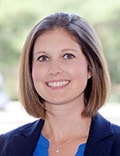Rebirth: Cancer Reshapes Nurse’s Life, Outlook, and Career

Tawny Roeder was 23 years old and 3 months away from getting her nursing degree at Briar Cliff University in Sioux City, IA, when she got a job as a training nurse. She was ready to take on the world, but first she had to clear an obstacle: She felt she lacked empathy for the patients in the oncology unit where she worked.

Tawny Roeder
“I knew no one with cancer at the time,” she says. “It hadn’t really impacted my life too much, so it was daunting to have to work with those patients.”
In one word, she felt “oblivious” about the struggles these patients experience. “I felt like I didn’t have the words to care for these people. It was something that scared me.”
She was also oblivious to something far scarier that lurked in her young life. She was on the dance team at Briar Cliff, and “I should have been in the best shape of my life,” but she found her energy and wind spent too easily.
At home during the 2008 spring break, her mom noticed her breathing difficulty. She also began having back pain that woke her up at night.
An X-ray showed a huge mass on her lung. Roeder got the results of a subsequent biopsy – lymphoma — over the phone, “which was awful. I was alone in my apartment.”
Just 2 weeks after starting to care for cancer patients in her hospital, Roeder became one. She studied for her nursing exams while undergoing chemotherapy with the help of her workmates.
Roeder’s journey was just beginning, though. She was diagnosed with an aggressive form of diffuse large B-cell lymphoma, a life-threatening blood cancer.
“There are several patients exactly like Tawny who are on their way to living when they are hit with this deal-breaker,” says Manali Kamdar, MD, clinical director of lymphoma services for University of Colorado Medicine. The diagnosis creates “a huge break in what happens in living a normal life.”
Roeder is one of 80,000 Americans diagnosed yearly with non-Hodgkin’s lymphoma, the most common form of lymphoma.
Kamdar says Roeder’s is one of 85 different subtypes, and she emphasizes that”it is absolutely important that patients get that subtype.” Sometimes it takes several tests, she says, but it is important to establish the subtype as this may influence management of the disease.
Kamdar also says there are now many different treatment options. Chemotherapy with the addition of medications has been a backbone of therapy, but now there are also chemo-free treatment options as well as approaches that involve genetically modifying a patient’s own immune cells, she says.
“The last 3 years have seen a sea change with the number of treatments that have been approved for patients with lymphoma. What I had in my toolkit 5 years ago is nothing compared to what I have today,” she says.
Roeder learned quickly that her cancer was so aggressive that she would need a stem cell transplant, during whichher healthy cells werecollected and stored while she underwent high-dose chemo, and would then be put back into her body intravenously.
However, thistreatment was not available in Sioux City. The closest center was in Omaha, NE, about a 90-minute drive away.
“I was absolutely terrified,” Roeder says. She and her then-boyfriend, Cody, decided to uproot from Sioux City and move to Nebraska. “We thought it might as well be a good place for us to get jobs.”
After a monthlong stay in the hospital while she underwent intensive treatment involving chemo and stem cell therapy, she eventually returned home. She now marks Sept. 11, 2008, as her “rebirth” after the treatment.
The night she returned, Cory proposed to her. “That was a very great coming-home surprise,” she says. “I had tubes hanging out of me. I was bald. I’m not sure it was the most romantic moment.”
The couple married the following May. Meanwhile, Roeder had started her nursing career in pediatrics, but “every time I would go to my oncology checkup, the doctor would say, ‘Come work for our team.'”
In 2011, she took her oncologist up on the offer and began working as a staff nurse in the oncology unit at the University of Nebraska Medical Center.
“It just kind of clicked,” she says. “This is probably why I’m still here. You sometimes have that survivor’s guilt as to why some survive and others don’t.”
Roeder’s treatment left her unable to bear children, so she and Cody have adopted a boy and a girl.
Now 37, in addition to working with lymphoma patients, she also volunteers for the Lymphoma Research Foundation to raise awareness and funding to fight the disease. “I have gained a lot of friendships — people I’ve been in contact with just because of their transplants,” she says.
Roeder, who has been cancer-free since, is now the case manager for lymphoma patients undergoing transplants. She inspires her new patients, especially those who feel alone in their disease journey. “Most are very shocked” when they hear her story, she says. “It’s really shocking for people to see that I look healthy. One hundred percent of the time it is well-received and very much appreciated.”
Sources
Tawny Roeder, Omaha, NE.
Manali Kamdar, MD, clinical director of lymphoma services, University of Colorado Medicine.
Source: Read Full Article